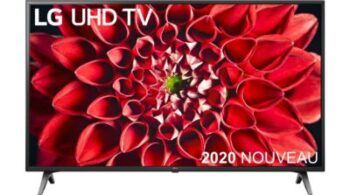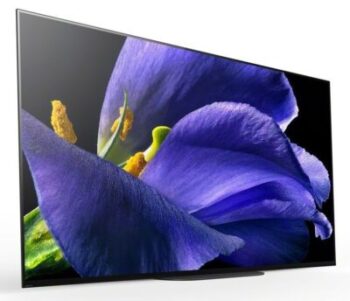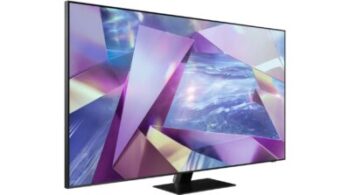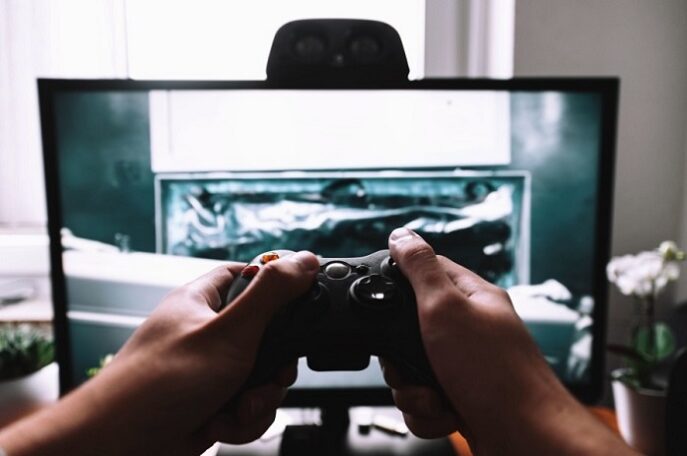The next generation of consoles (PS, Xbox X Series) are coming, ready to run great 4K HDR games. To get the most out of the upcoming titles, you'll probably need a gaming TV. But which model should you choose based on your budget? Are all brands the same? We answer these questions and more in this guide to buying the best gaming TVs.
Here is our commitment, to make sure that we provide the best user experience and content quality:
You can support us by using our links to make your purchases (at no extra cost to you)! This sometimes earns us a commission which allows us to remain independent. More about us
Our selection
"The LG 55BX6 is exceptional for gaming. This 55-inch 4K HDR TV features VRR support to reduce screen tearing. The response time is almost instantaneous,…"
"The LG 43UN71006 is aimed at small budgets looking for decent overall performance. You will still have to accept limited functionality. This TV has a…"
"The Sony Bravia KD55AG9 is sure to please the most demanding gamers. This 4K HDR TV for video games offers extremely fast response time and…"
"The Samsung QE65Q700T is an 8K TV designed for video games. It has a very low input lag and a more than decent response time.…"

The LG 55BX6 is exceptional for gaming. This 55-inch 4K HDR TV features VRR support to reduce screen tearing. The response time is almost instantaneous, with very little input delay.
952 £ on BoulangerLike most OLED TVs, the LG 55BX6 offers excellent overall performance. This 55-inch 4K TV has an infinite contrast ratio and perfect black uniformity and depth, ideal for watching movies in a dark room. Gamers will appreciate its FreeSync variable refresh rate (VRR) support and G-SYNC compatibility.
The response time is 3.8 ms at 100%. More importantly, it becomes almost instantaneous at 80%, only 0.2 ms! This translates into clear motion. But low frame rate content can stutter. This TV has wide viewing angles, an excellent choice for a wide seating arrangement. While it doesn't get bright enough to fight glare, it has excellent reflection management, so it works well in most fairly bright rooms.

The LG 43UN71006 is aimed at small budgets looking for decent overall performance. You will still have to accept limited functionality. This TV has a low input lag and a decent response time. It does a good job of playing games.
See the priceThe LG 43UN71006 is a 43-inch 4K LED TV with a native refresh rate of 60 Hz. This TV has incredibly low input latency. You need to be in gaming mode to get the lowest possible input lag. There is also an Auto Low Latency mode that automatically switches the TV to game mode when you launch a game from a compatible console. Response time remains decent, with 5.7ms at 80% and 18.6ms at 100%.
The LG 43UN71006 displays a decent color gamut thanks to HDR10 support. However, the display result does not match a wide color gamut. This TV has good coverage of the DCI P3 color space that games commonly use, but offers disappointing coverage of the wider Rec range.

The Sony Bravia KD55AG9 is sure to please the most demanding gamers. This 4K HDR TV for video games offers extremely fast response time and low input lag. However, it does not support VVR FreeSync.
1 119 £ on BoulangerThe Sony Bravia KD55AG9 has a 55-inch screen. It displays 4K images with a native refresh rate of 100 Hz. This TV has a very low input lag. You will get the lowest possible lag on a Full HD resolution at 120 Hz (18.8 ms) 2 picture modes will get you there: game mode or graphics mode. You can use either one for proper 4:4:4 chroma support. However, Game mode is recommended. Unfortunately, enabling motion interpolation adds a significant amount of lag.
A point that matters to gamers, the response time is simply superb, almost instantaneous, with clear images and no motion blur. Like all OLED TVs, the Sony Bravia KD55AG9 has an infinite contrast ratio, capable of producing perfect blacks. It offers an excellent HDR experience thanks to its wide color gamut. While it doesn't have advanced gaming features like FreeSync variable refresh rate, most gamers will appreciate the support for Dolby Vision and eARC.

The Samsung QE65Q700T is an 8K TV designed for video games. It has a very low input lag and a more than decent response time. If you like to play in the dark, its high contrast ratio makes blacks look deep.
See the priceThis 65-inch 8K TV has a native refresh rate of 100 Hz, which can go up to 120 Hz. This TV will be worth every penny invested. It has incredibly low input lag as long as Game mode is enabled. This lag is slightly higher when VRR or Game Motion Plus is enabled, ditto when configured at 8K 120Hz + HDR. However, this should not be noticeable to casual gamers.
The Samsung QE65Q700T has a decent response time. There is a bit of blurring behind fast moving objects, and the transition from 0-20% seems a bit slow, leading to a bit more motion blur in gaming phases where dark dominates. This TV uses a VA panel with a fantastic contrast ratio and remarkable black uniformity, producing deep blacks even though it lacks a local dimming feature. Note the great color accuracy.
Any specific needs?
Best TV for video games in 2021
Best TV for entry-level video games
Best TV for high-end video games
Your guide :
Rate this buying guide :By rating this buying guide, you are helping us to reward our best writers. Thank you!
| TOP OF THE LINE | CHEAP | TOP OF THE LINE | EXCELLENT | |

In accordance with our commitment, this buying guide does not contain any sponsored products. |
 9/10 |
 7/10 |
 9/10 |
 8/10 |
| OUR SELECTION |
LG 55BX6
|
LG 43UN71006
|
Sony Bravia KD-55AG9
|
Samsung QE65Q700T
|
|
The LG 55BX6 is exceptional for gaming. This 55-inch 4K HDR TV features VRR support to reduce screen tearing. The response time is almost instantaneous, with very little input delay.
|
The LG 43UN71006 is aimed at small budgets looking for decent overall performance. You will still have to accept limited functionality. This TV has a low input lag and a decent response time. It does a good job of playing games.
|
The Sony Bravia KD55AG9 is sure to please the most demanding gamers. This 4K HDR TV for video games offers extremely fast response time and low input lag. However, it does not support VVR FreeSync.
|
The Samsung QE65Q700T is an 8K TV designed for video games. It has a very low input lag and a more than decent response time. If you like to play in the dark, its high contrast ratio makes blacks look deep.
|
|
|
Screen size
|
43-inch
|
43 inches
|
55-inch
|
65-inch
|
|
Resolution
|
4K (3840 x 2160 pixels)
|
4K (3840 x 2160 pixels)
|
4K (3840 x 2160 pixels)
|
8K (7680 x 4320 pixels)
|
|
Native refresh rate
|
100 Hz
|
60 Hz
|
100 Hz
|
100 Hz
|
|
Input latency (4K at 60 Hz)
|
14.5 ms
|
10.3 ms
|
27.2 ms
|
9.1 ms
|
|
100% response time
|
3.8 ms
|
18.6 ms
|
1.9 ms
|
15.0 ms
|
Help us improve this table:
Report an error, request the addition of a feature to the table, or suggest another product. Thank you for your kindness!
We spend thousands of hours each year studying the major specialized websites, analyzing products of hundreds of brands and reading user feedback to advise you on the best products.
We are a product review company with a single mission: to simplify your buying decisions. Our research and testing helps millions of people every year find the best products for their personal needs and budget.
To support us you can: use our links to make your purchases (which often earns us a small commission), share our articles on social networks, or recommend our site on your blog. Thanks in advance for your support!

First of all, you should focus on buying a TV with a low input latency of 30ms or less. Input latency is the time it takes for a particular TV to render the image data sent from the game console.A high input lag won't matter much for a puzzle game, strategy game, or a title that relies on contemplation and/or reflection, but will be essential on a fighting game or FPS (first-person shooter), especially in competition, where a fraction of a second can make all the difference.
If you're looking for a TV for video games, the most basic requirement is 4K resolution. The Xbox One S and PS4 Pro, for example, run all their games in 4K thanks to built-in upscaling. The Xbox One Series X, meanwhile, displays games in native 4K resolution, as does the PS5.
Unless you're a competitive gamer or an absolute FPS fan, a 60 Hz TV will do. Otherwise, aim for 120 Hz. Now that the Xbox One Series X and PS5 are out and games with native 4K resolution at 60 frames per second will be out soon, make sure the TV you buy has the latest HDMI standards. If it doesn't have at least one HDMI socket that complies with the v2.0a specification, the TV won't be able to display 4K resolution at more than 30 frames per second.
Along with
4K resolution, support for High Dynamic Range (HDR) technology is a minimum to get the most out of today's video games. This technology allows a TV to display images with a much wider range of light than standard dynamic range (SDR) images. The goal of HDR is to bring the images we see on our screens closer to the way our eyes see the real world. The PS5, as well as the latest generation consoles like the PS4 and Xbox One, display games in HDR. The Xbox Series X also supports Dolby Vision, a dynamic HDR format with great contrast.
When considering HDR, you also need to think about the color depth of your TV for video games. Color depth is expressed in bits. The best HDR experience requires a 10-bit display capable of supporting 1024 values of each RGB color. Today, most high-end HDR TVs are 10-bit, but this is far from a given at the entry level. Xbox and PlayStation consoles automatically evaluate the bit depth of your TV and select the optimal HDR video output accordingly. To be clear, it's entirely possible for an 8-bit TV to deliver good HDR color performance if it has a powerful video processing engine.
Now that OLED TVs are relatively affordable, they're tempting options if you have the budget for them. The hardware-induced motion blur you often see with LCDs is virtually nonexistent with OLED displays. An OLED panel can also be the best choice for local multiplayer titles. This is because there is virtually no change in color or brightness when the viewing angle is shifted, unlike what you get with an LCD. But you don't have to have an OLED TV to enjoy a decent gaming experience. In fact, TVs with very low input latency and very high brightness still tend to use LCD panels.
It's generally wise to future-proof your TV, no matter how you use it, but this is especially true for video games. The console market often pushes the limits of technology and developments become difficult to predict. Who could have anticipated the PS4 Pro or Xbox One X in 2013? You're probably committed to keeping your TV for several years, and you don't want to buy a model that will become obsolete shortly after you take it out of the box.
Supporting 4K and HDR is the easy part. Your new video game TV will support at least my 4K, and probably HDR as well. Instead, you need to think about the features that require a deeper dive into the spec sheets.
While you don't have to worry about refresh rates beyond 60Hz, you'll want to make sure you have the broadest possible HDR support. Both the PS4 Pro and Xbox One X rely on HDR10 for their enhanced visuals, but Dolby Vision support (present on sets from brands like LG, TCL and Vizio) can be useful if future consoles or firmware updates take advantage of it.
And don't forget connectivity. You'll need as many HDMI 2.0 ports as you can get (some vendors may only include one), and preferably more ports than you need right away. Multi-console households are becoming more common. You might also consider a TV with Bluetooth audio support.
Wireless headphones might be useful if you want to play while someone is sleeping. And don't forget to consider other factors. Ideally, you want to buy a TV that can fit into your life, and that means thinking about where, when and how you might play in the years to come.
In this section, we will look at the differences between the types of TVs for video games. We will focus on LCD/LED, QLED and OLED TVs.

While LCD and LED TVs are often considered separate technologies, they both create their image in the same way, with a liquid crystal display. A liquid crystal display is a thin, translucent panel made up of millions of tiny cells called pixels filled with liquid crystal. Each of the pixels can change opacity when a charge is applied. Red, blue and green color filters give each pixel the ability to create color as well. When light passes through the pixels from behind, you get the building blocks of a visible image.
The main difference between LCD TVs and LED TVs is that LCD TVs use fluorescent lamps to provide their backlighting, while LED TVs use, as you may have guessed, LED lamps. LEDs are much smaller than fluorescent lamps, so the TV can be much thinner. They also use a little less energy, so LED TVs become more energy efficient.
An LED TV also has a system that turns off some of the backlights during high-contrast scenes so that the lights can be brighter and the dark parts can be darker: this is local dimming. The picture will be better.

To understand what distinguishes QLED TVs from other technologies, it is best to start by talking about quantum dots. These dots are incredibly small artificial crystals that glow when excited by an energy source.
QLED TVs place a layer of these crystals, or quantum dots, in front of a blue LED backlight. The blue backlight excites the quantum dots, making them glow. The combination of the LED backlight and the bright quantum dots allows QLED TVs to produce incredibly vibrant colors and excellent brightness. However, the use of a backlight limits the ability of QLED TVs to achieve the deep blacks possible with OLED TVs where each pixel produces its own light.

Of the different types of TVs available today, the OLED TV is the most unique. OLED (or organic light-emitting diode) TVs are similar to LED TVs, but there is one major difference. Each individual pixel is capable of creating light, color and opacity on its own. This means that manufacturers can completely eliminate backlighting. As a result, OLED TVs can be a few millimeters thick, because backlights add weight and depth to TVs.
Also, because brightness can be controlled at the pixel level, OLED TVs can produce incredible contrast. Unlike other types of TV screens, OLEDs can actually turn off individual images, allowing them to create deep blacks that simply aren't possible with other technologies. Simply put, OLED TVs create the most beautiful and vivid picture of any TV currently available.
OLED (organic light-emitting diode) is a type of display technology that consists of a carbon-based film through which two conductors pass a current, causing it to emit light. Basically, this light can be emitted pixel by pixel. Thus, a bright white or colored pixel can appear next to one that is completely black or of an entirely different color, without any impact on the other.
Other advantages of OLED are that the panels are lighter and thinner than a typical LCD/LED panel, viewing angles tend to be much wider and response times can be extremely fast. This is ideal for fighting games and FPS.
Among the drawbacks is the fact that OLED panels are relatively expensive to produce. However, prices are now becoming more affordable, largely thanks to LG selling panels to other manufacturers like Sony, Panasonic and Philips. Size can also be an issue when it comes to OLED TVs.
Until very recently, you couldn't buy an OLED TV under 55 inches. Although there is now a 48-inch OLED TV from LG. But in the grand scheme of things, you're not really spoilt for choice if you don't want a big TV.
The only major TV manufacturer that hasn't jumped on the OLED bandwagon is Samsung, which instead promotes a competing technology called QLED. QLED (Quantum Dot Light Emitting Diode) technology has, in theory at least, a lot in common with OLED technology, especially in the fact that each pixel can emit its own light.
Here, this is achieved by means of quantum dots. These are tiny semiconductor particles that measure only a few nanometers. These quantum dots are (again, in theory) capable of giving off incredibly bright, vibrant and diverse colors, even more so than OLED.
The problem is that the quantum dots in current QLED TVs don't actually emit their own light. Instead, they simply pass light from a backlight, in the same way as an LCD layer on standard LCD/LED TVs. Quantum dots improve color vibrancy and control on the LCD, but it's not quite the revolutionary next-generation technology Samsung has always claimed.
Samsung's QLED TVs offer a brighter, more impactful picture than their OLED rivals, and in recent years they've closed the gap impressively in terms of black depth and viewing angles.
However, OLED still has a slight edge in this regard, and while OLED TVs aren't as bright as QLEDs, their self-emitting properties create absolutely stunning contrast. When it comes to video games, the differences are minimal.
In summary, both OLED and QLED are capable of exceptional results, especially on video games. And it's probably best not to aim for a specific technology and instead just look for the best TV you can afford.
Use a new HDMI cable
With a new cable, you can be sure that all of the latest video standards are supported for the best possible picture quality. Since the latest video signals such as 4K and HDR use a lot of data, an older HDMI cable may not be able to properly transmit these signals. A new cable is usually included with your console. So use it!
Set your TV to Game mode
Newer TVs have features that allow you to enhance the picture. It is possible to make the picture much smoother and the colors much brighter, for example. These changes have only a minor effect on the image of your console. But they do have one major drawback: they can cause input lag. This means that your TV needs time to do all the calculations, causing the picture to lag behind the action that is happening in the game. With game mode, you can turn off all the features that consume resources
Set the aspect ratio to Full Screen
Generally
, by default, your TV is set to a 16: 9 aspect ratio. In this aspect ratio, your screen is enlarged. This is also called overscanning. This causes you to lose part of the screen. If you set your TV's aspect ratio to "Full Screen", you zoom out, allowing you to see much more information. This gives you a better overview of what's going on in your game. Try switching between Full Screen and 16: 9 to see which setting works best for you.
Choose the right color settings
Every
TV has a different color and every player has a different preference. That's why you should take the time to calibrate the colors and contrast to match your preferences. Modern televisions usually have some presets, but also manual adjustment of color, contrast, and brightness.
Adjust audio latency
If
you find that the picture and sound are out of sync, you can easily fix that with the "Audio Delay" option, found on most modern TVs. Adjust this option after setting your TV to Game mode. If you are using a soundbar, set the audio delay option on the soundbar instead.
The best TV for gaming depends on your needs and your budget. Read our buying guide to find out which products are best.
Currently on the market, there are reference brands in terms of TVs for video games. Among them are Samsung, Sony, LG and TCL.
8K is a very young resolution that is only just beginning to make inroads into the consumer market. Especially since there are no game projects with native 8K resolution yet. For the time being, a 4K screen will be more than enough to enjoy the most graphically impressive video games.
When it comes to a video game TV, 1 inch equals 2.54 cm. So a 32-inch gaming TV has a diagonal measurement of 81.28 cm.
The viewing angle is a vital specification for placing a TV in a room where some of the seating may be off-center. If the TV you're interested in doesn't provide viewing angle information, check user reviews online or go see the TV in person at a local store. The color and light levels of a TV can fade when viewed from a certain angle.
Every month we help more than 1 000 000 people buy better and smarter.
Copyright © 2022 - Made with ♥ by buyingbetter.co.uk
Your reviews and buying guides 0% advertising, 100% independent!